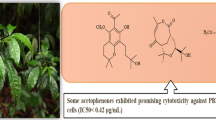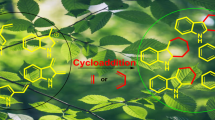Abstract
Podophyllotoxin is a well-known natural antitumor agent with severe side effects, which led us to synthesize its numerous analogs in search of product(s) of improved therapeutic potential. Here, we report an efficient method for the synthesis of a series of 4-O-podophyllotoxin estolides with spectral characteristics and their biological studies. The OH of a known molecule, 4-O-podophyllotoxinyl 12-hydroxyl-octadec-Z-9-enoate 2, was coupled with the carboxylic groups of different FA with the help of dicyclohexylcarbodiimide and dimethyl aminopyridine (catalyst) to produce high yields of their respective C4α-estolides 3–11. Spectroscopic techniques, particularly 1H and 13CNMR, proved to be suitable tools to characterize the new compounds. These molecules of greater lipophilic character were tested for their in vitro cytotoxicity against four human solid tumors, one human leukemia cell, and one noncancerous cell. Compounds 4–6 and 11 showed moderate antileukemic activity; unexpectedly, none were found to be active against solid tumors. Estolides were also investigated for their in vitro activity against tubulin and topoisomerase II proteins. All the compounds showed inhibition of the catalytic activity of topoisomerase II, whereas 6–8 also inhibited tubulin polymerization. These results suggest the need for further screening of these molecules against a larger panel of cancerous cells.
Similar content being viewed by others
Abbreviations
- BT549:
-
ductal breast carcinoma cell line
- DCC:
-
dicyclohexylcarbodiimide
- DMAP:
-
dimethyl aminopyridine
- HL-60:
-
human leukemia cell line
- IC50 :
-
concentration of a test compound that prevented 50% of the substrate from being converted to the product
- KB:
-
human epidermal carcinoma cell line
- kDNA:
-
kinetoplast DNA
- SK-MEL:
-
human malignant melanoma cell line
- SK-OV3:
-
human ovary carcinoma cell line
- VERO:
-
monkey kidney fibroblast cell line
References
Gordaliza, M., Castro, M.A., Miguel del Correl, J.M., and Feliciano, A.S. (2000) Antitumor Properties of Podophyllotoxin and Related Compounds, Curr. Pharm. Design 6, 1811–1839.
Brewer, C.F., Loike, J.D., Horwitz, S.B., Sternlicht H., and Gensler, W.J. (1979) Conformational Analysis of Podophyllotoxin and Its Congeners. Structure-Activity Relationship in Microtuble Assembly, J. Med. Chem. 22, 215–221.
Jardine, I. (1980) Podophyllotoxin, in Anticancer Agents Based on Natural Product Models (Cassady, J.M., and Douras, J.D., eds.), Academic Press, New York, pp. 319–351.
Keller-Juslen, C., Kuhn, M., Stahelin, H., and von Wartburg, A. (1971) Synthesis and Antimitotic Activity of Glycosidic Lignan Derivatives Related to Podophyllotoxin, J. Med. Chem. 14, 936–940.
Weiss, S.G., Tin-wa, M., Perdue, R.E., Jr., and Farnsworth, N.R. (1975) Potential Anticancer Agents II: Antitumor and Cytotoxic Lignans from Linum album (Linaceae), J. Pharm. Sci. 64, 95–98.
O'Dwyer, P.J., Alonso, M.T., Leyland-Jones, B., and Marsoni, S. (1984) Teniposide: A Review of 12 Years of Experience, Cancer Treat. Rep. 68, 1455–1466.
Issell, B.F., Muggia, F.M., and Carter, S.K.(eds.) (1984) Etoposide (VP-16) Current Status and New Developments, Academic Press, New York.
VePesid® Product Information Overview, Bristol Lab, New York, 1983.
van Maanen, J.M.S., Retel, J., De Vries, J., and Pinedo, H.M. (1988) Mechanism of Action of Antitumor Drug Etoposide: A Review, J. Natl. Cancer Inst. 80, 1526–1533.
Damayanthi, Y., and Lown, J.W., (1998) Podophyllotoxins: Current Status and Recent Developments, Curr. Med Chem. 5, 205–252.
Lee, K.H. (1999) Novel Anticancer Agents from Higher Plants, Med. Res. Rev. 19, 569–596.
Nagao, Y., Mustafa, J., Sano, S., Ochiai M., Tazuko, T., and Shigeru, T. (1991) Different Mechanism of Action of Long Chain Fatty Acid Esters of Podophyllotoxin and Esters of Epipodophyllotoxin Against P388 Lymphocytic Leukemia in Mice, Med. Chem. Res. 1, 295–299.
Mustafa, J., Khan, S.I., Ma, G., Walker, L.A., and Khan, I.A. (2004) Synthesis and Anticancer Activities of Fatty Acid Analogs of Podophyllotoxin, Lipids 39, 167–172.
Coon, J.S. (1993) Methods and Compositions Using Fatty Acid Esters for Reducing Multi-drug Resistance in Cancer Treatment, PCT Int. Appl. 38, Application WO 92-US10563.
Scott, C.A., and Horrobin, D.F. (1998) Fatty Acids for the Prevention of Side Effects of Chemotherapy, PCT Int. Appl. 17, Application WO 97-GB2362 19970902.
Lundberg, B., (1994) The Solubilization of Lipophilic Derivatives of Podophyllotoxins in Sub-micron Sized Lipid Emulsions and Their Cytotoxic Activity Against Cancer Cells in Culture, Int. J. Pharm. 109, 73–81.
Levy, R.K., Hall, I.H., and Lee, K.L., (1983) Antitumor Agents LXII: Synthesis and Biological Evaluation of Podophyllotoxin Esters and Related Derivatives, J. Pharm. Sci. 72, 1158–1161.
Paddon-Jones, G.C., McErlean, C.S.P., Hayes, P., Moore, C.J., Konig, W.A., and Kitching, W. (2001) Synthesis and Stereochemistry of Some Bicyclic γ-Lactones from Parasitic Wasps (Hymenoptera: Braconidae). Utility of Hydrolytic Kinetic Resolution of Epoxides and Palladium(II)-Catalyzed Hydroxycyclization-Carbonylation-Lactonization of Ene-diols, J. Org. Chem. 66, 7487–7495.
Lie Ken Ji, M.S.F., Mustafa, J., and Pasha, M.K., (1999) Synthesis and Spectral Characteristics of Some Unusual Fatty Esters of Podophyllotoxin, Chem. Phys. Lipids 100, 165–170.
Shi, Q., Chen, K., Morris-Natschke, S.L., and Lee, K.H., (1998) Recent Progress in the Development of Tubulin Inhibitors as Antimitotic Antitumor Agents, Curr. Pharm. Des. 4, 219–248.
Wang, H.K., Morris-Natschke, S.L., and Lee, K.H., (1997) Recent Advances in the Discovery and Development of Topoisomerase Inhibitors as Antitumor Agents Med. Res. Rev. 4, 367–425.
Author information
Authors and Affiliations
Corresponding author
About this article
Cite this article
Mustafa, J., Khan, S.I., Ma, G. et al. Synthesis, spectroscopic, and biological studies of novel estolides derived from anticancer active 4-O-podophyllotoxinyl 12-hydroxyl-octadec-Z-9-enoate. Lipids 39, 659–666 (2004). https://doi.org/10.1007/s11745-004-1279-2
Received:
Accepted:
Issue Date:
DOI: https://doi.org/10.1007/s11745-004-1279-2




